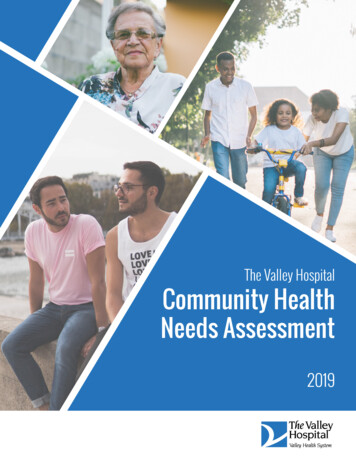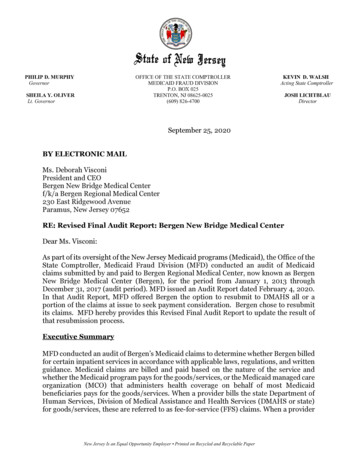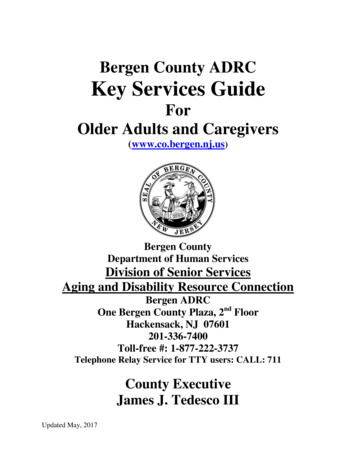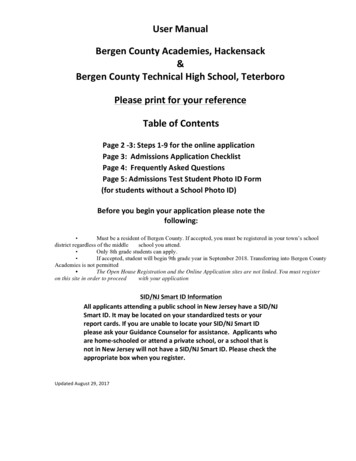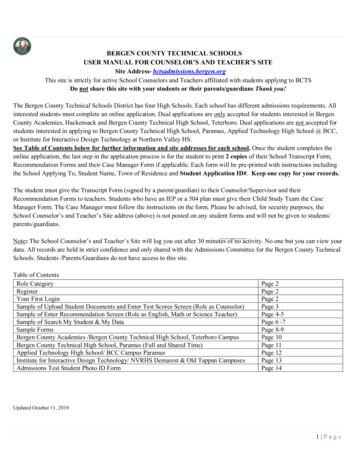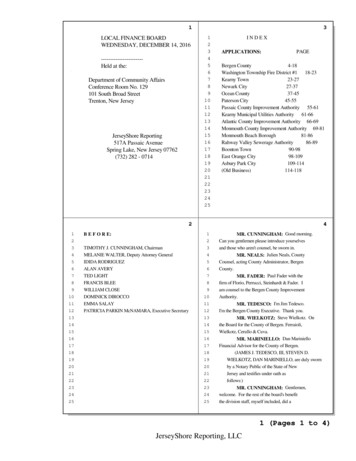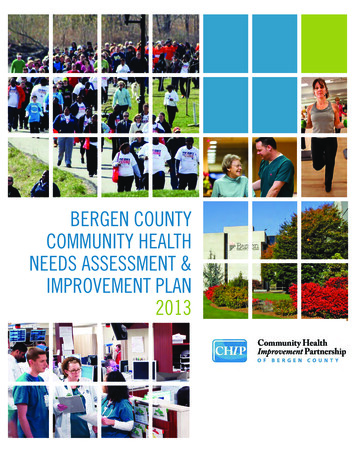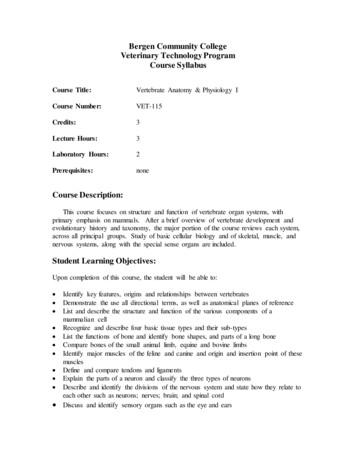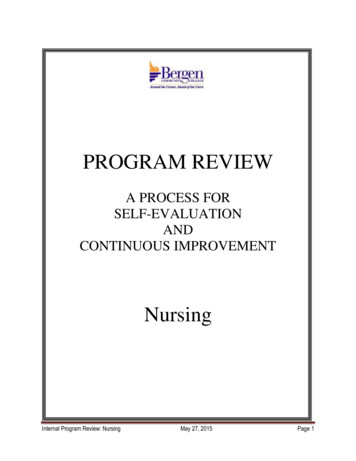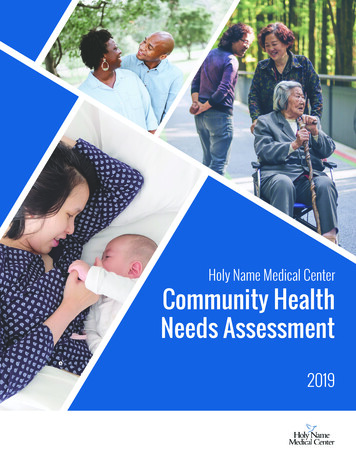
Transcription
Bergen NewHolyBridgeName Medical CenterCommunity HealthNeeds Assessment2019
ACKNOWLEDGMENTSThe Bergen County Community Health Needs Assessment (CHNA) and Strategic Planning process wasmade possible through the generous support of Bergen New Bridge Medical Center, Englewood Health,Hackensack Meridian Health Hackensack University Medical Center, Hackensack Meridian HealthPascack Valley Medical Center, Holy Name Medical Center, Ramapo Ridge Psychiatric Hospital (a part ofChristian Health Care Center), and The Valley Hospital. Representatives from these seven hospitals,along with representatives of the Bergen County Department of Health Services (BCDHS) and theCommunity Health Improvement Partnership (CHIP) of Bergen County, worked collaboratively for morethan a year to plan and execute this assessment. A Steering Committee comprised of representativesfrom each hospital and BCDHS guided this project. John Snow, Inc. (JSI) was hired by the SteeringCommittee to assist with the assessment.Hundreds of individuals who live, work, and learn in Bergen County were engaged to participate in theassessment process. JSI administered a mail-based random household survey and receivedapproximately 1,350 responses; the survey oversampled in areas of the County with higher percentagesof Black/African American residents, Hispanic/Latino residents, and low-income households to achieve asample that was representative of Bergen County demographics. Information was also gathered throughinterviews, focus groups, and community listening sessions. Finally, over 350 community residentsresponded to a web-based survey to capture opinions and perceptions of leading social determinants ofhealth, barriers to care, vulnerable populations, and access to health care services.The information gathered throughout this assessment will allow the hospitals, the BCHDS, the CHIP, andhealth and social service providers to gain a better understanding of health needs and barriers to care inBergen County. The assessment results will be used to guide the development of strategic plans toaddress these issues and improve where, when, and how healthcare is provided. The SteeringCommittee would like to extend their sincere appreciation to all those who invested their time, effort,and expertise to ensure the development of a comprehensive and robust assessment.2019 BERGEN COUNTY COMMUNITY HEALTH NEEDS ASSESSMENT STEERINGCOMMITTEECarolyn Bryan, Hackensack Meridian Health Pascack Valley Medical CenterDonnalee Corrieri, Bergen New Bridge Medical CenterColette Cummings, The Valley HospitalRebecca Dauerman, Ramapo Ridge Psychiatric Hospital (part of Christian Health Care Center)Balpreet Grewal-Virk, Hackensack Meridian Health Hackensack University Medical CenterMarianne Kennelly, Ramapo Ridge Psychiatric Hospital (part of Christian Health Care Center)Marla Klein, Bergen County Department of Health ServicesElisabeth Lucas, The Valley HospitalLauren Menkes, Englewood HealthElizabeth Rubock, Bergen County Department of Health ServicesJennifer Yanowitz, Englewood HealthCatherine Yaxley, Holy Name Medical Center1
EXECUTIVE SUMMARYOVERVIEW AND PURPOSEThis Community Health Needs Assessment (CHNA) and the associated Implementation Strategy (IS)were prepared for Holy Name Medical Center. Holy Name is a comprehensive 361-bed acute care facilitythat provides technologically advanced, compassionate and personalized care across a continuum thatencompasses education, prevention, diagnosis, treatment, rehabilitation and wellness maintenance.Holy Name has nearly 4,000 employees and admits about 30,000 patients each year. The Medical Centerhas a national reputation for providing culturally sensitive care to a diverse population, drawing patientsfrom across the New York City region to its specialty centers and renowned doctors. The hospital isknown as a high quality, low cost provider of extraordinary clinical care given by compassionate andhighly trained physicians and staff.In addition to its commitment to clinical excellence and respect, Holy Name is committed to being anactive partner and collaborator with the communities it serves. The Medical Center acknowledges itsrole as a critical community resource, but also recognize the value in collaborating with communitypartners to identify, educate, prevent, and address issues that prevent community residents fromaccessing the health and social services they need. Through its community benefit programming, HolyName strives to create and support opportunities for residents of the service area to lead healthy andproductive lives.The CHNA was conducted in collaboration with the Bergen County Department of Health Services(BCDHS), the Community Health Partnership of Bergen County (CHIP), and the other six acute carefacilities in Bergen County: Bergen New Bridge Medical Center, Englewood Health, Hackensack MeridianHealth Hackensack University Medical Center, Hackensack Meridian Health Pascack Valley MedicalCenter, Ramapo Ridge Psychiatric Hospital (part of Christian Health Care Center), and The ValleyHospital. The assessment engaged hundreds of community residents throughout Bergen County, and arange of other community stakeholders, including service providers, community advocates, state andlocal public officials, faith leaders, and representatives from community-based organizations. Theprocess that was applied to conduct the CHNA and develop the Implementation Strategy exemplifies thespirit of collaboration and community engagement that is such a vital part of Holy Name MedicalCenter’s mission.This CHNA provides information that will be used to ensure that Holy Name Medical Center’scommunity health programs are appropriately focused and are delivered in ways that are responsive tothe needs of those in its primary service area. The assessment also allows Holy Name, as a non-profitentity, to fulfill federal Community Benefits requirements per the Federal Internal Revenue Service (IRS)as part of the Affordable Care Act.2
APPROACH AND METHODSThe assessment began in December 2018 and was conducted in three phases, which allowed for thecollection of an extensive amount of quantitative and qualitative data (Phase 1); engagement ofcommunity residents, key stakeholders, and service providers (Phase 2); and analysis and prioritizationof findings for use in developing a data-driven Implementation Strategy (Phase 3).2019 Bergen County CHNA: Project PhasesPhase 1Preliminary Assessment andEngagement Secondary Data CollectionKey Informant InterviewsResource InventorySteering Committee MeetingsPhase 2Targeted Engagement Bergen County RandomHousehold SurveyFocus GroupsCommunity Listening SessionsBergen County CommunityHealth Perceptions SurveySteering Committee MeetingsPhase 3Strategic Planning and Reporting Steering CommitteePrioritization MeetingIndividual Hospital andBCHDS/CHIP PrioritizationMeetingFinal ReportingMany individuals from across Bergen County were engaged in the assessment and planning process,including: Health and social service providersBCDHS and CHIP leadership and staffFaith leadersCommunity residents Hospital leadership, clinicians, and staffHealth and public health officialsCommunity organizers and advocatesHOLY NAME MEDICAL CENTER COMMUNITY HEALTH PRIORITIES AND VULNERABLEPOPULATIONSThe CHNA was designed as a population-based assessment, meaning the goal was to identify a full rangeof community health issues across the demographic and socioeconomic segments of the population. Theissues identified were framed in a broad context to ensure that the breadth of unmet needs andcommunity health issues were recognized.Following an integrated analysis of assessment findings, and prioritization/strategic planning discussionswith Holy Name’s leadership and staff, four priority areas emerged: chronic and complex conditions1and risk factors, mental health and substance use disorder, and social determinants of health and accessto care.To plan community health initiatives and to comply with federal guidelines, there was an effort toidentify segments of the population with complex health needs or that face significant barriers to care.1Literature defines complex chronic conditions as those that “involve multiple morbidities that require the attention ofmultiple health care providers or facilities and possibly community (home)-based care. A patient with complex chronic diseasepresents to the health care system with unique needs, disabilities, or functional limitations.” Managing Complexity in ChronicCare. Arlington, VA: Department of Veterans Affairs, Office of Research and Development; 2006.3
Given the assessment findings and Holy Name’s clinical expertise, five population segments wereidentified: older adults, individuals with chronic/complex conditions, racially/ethnically/culturallydiverse populations, individuals with limited resources, and youth/adolescents.Chronic/ComplexConditions andRisk FactorsMental Healthand SubstanceUse DisorderSocial Determinantsof Health and Accessto CareOlder AdultsIndividuals withChronic/ComplexConditionsRacially, Ethnically,and CulturallyDiverse PopulationsIndividuals withLimited ResourcesYouth andAdolescents4
KEY FINDINGS/THEMESBelow is a listing of key findings and themes, organized by chapters of the CHNA report. These findingswere used as the basis for the development of Holy Name’s Implementation Strategy. For more detailedfindings, data sources, and data on disparities by gender identity, race/ethnicity, income, and age,please see the full Community Health Needs Assessment report. Key findings are listed in the order inwhich they are discussed in this Community Health Needs Assessment report and are not hierarchical.Key Findings: Wellness, Prevention, and Risk Factors All-cause and premature mortality were lower in Bergen and Hudson Counties than New Jersey overall One-third (33.2%) of Bergen County Random Household Survey respondents were overweight, whileapproximately one in five were obese (22.8%) Nearly a third (32.9%) of Bergen County Random Household Survey respondents reported that they did notparticipate in any physical activity or exercise in the past 30 days Over 70% of Bergen County Random Household Survey respondents reported that they had a primary carevisit and a dental visit within the past year Individuals engaged during this assessment prioritized the risk factors associated with chronic and complexconditions (e.g., obesity, poor nutrition, sedentary lifestyle) as key issues of concernKey Findings: Chronic and Complex Conditions Heart disease (#1) and cancer (#2) were the leading causes of death in Bergen and Hudson Counties Approximately 1 in 4 (26.5%) Bergen County Random Household Survey respondents had been diagnosed with high blood pressureApproximately 1 in 10 (9.7%) Bergen County Random Household Survey respondents had ever been diagnosedwith cancerApproximately 1 in 10 (11.5%) Bergen County Random Household Survey respondents had ever beendiagnosed with diabetes.14.1% of Bergen County Random Household Survey respondents had been diagnosed with asthmaInfluenza and pneumonia mortality rates were significantly high in Bergen County compared to New JerseyoverallIndividuals engaged in this assessment identified older adults, especially those with multiple chronicconditions and those who lack a regular caregiver, as a vulnerable populationKey Findings: Mental Health and Substance Use Disorder 6.8% of Bergen County Random Household Survey respondents reported that their mental health was poor for 15 or more days in the past monthNearly 1 in 10 (9.7%) of Bergen County Random Household Survey respondents had ever been diagnosed witha depressive disorderOver 1 in 10 (12.7%) of Bergen County Random Household Survey respondents had ever been diagnosed withan anxiety disorder18.9% of Bergen County Random Household Survey respondents were current smokersIndividuals engaged in this assessment characterized e-cigarette and vaping as a critical concern, especially foryouth and adolescents15.4% of Bergen County Random Household Survey respondents reported binge drinking in the past 30 daysDrug-related deaths in Bergen County have increased since 2014, from 8.8 deaths to 13.8 deaths per 100,000The number of suspected opioid-overdose deaths has continued to increase annually since 2014; the numberof opioids dispensed has decreased annually since 20155
Key Findings: Social Determinants of Health and Access to Care The percentage of foreign-born residents and non-English speakers were significantly high in Bergen and Hudson Counties compared to the state overall. Nearly half of Hudson County residents identified asHispanic/LatinoIn Bergen County, educational attainment was high and unemployment was low compared to the state.In Hudson County, educational attainment was low and unemployment was high compared to the state.The percentage of individuals and families in poverty is low in Bergen County compared to New Jersey overall.Despite this, individuals engaged in this assessment reported that there were pockets of poverty throughoutBergen County, even in affluent communities, and income, poverty, and employment were issues of concernThe percentage of individuals and families in poverty in Hudson County was significantly high compared to thestateIndividuals engaged in this assessment identified housing issues – including lack of housing stock and housingaffordability –as a major barrier to good health and well-beingIndividuals engaged in this assessment identified access to transportation resources, especially for olderadults, low-income populations, and those without a personal vehicle as a barrier to accessing health andsocial servicesNearly one-fifth (18.5%) of respondents to the Bergen County Random Household Survey reported that it wasvery or somewhat difficult to buy fresh produce or vegetablesLess than 10% of Bergen County residents lacked health insurance. Despite this, respondents to the BergenCounty Random Household Survey identified lack of health insurance as the leading social factor or barrierthat limited access to care or impacted the health of those living in the community6
TABLE OF CONTENTSAcknowledgments . 1Executive Summary . 2Background and Approach . 8Overview & Purpose .8Approach & Methods . 10Population Characteristics and Social Determinants of Health . 16Key Findings . 26Key Findings: Wellness, Prevention, and Risk Factors . 26Overall Health Status . 26Nutrition & Weight . 28Physical Activity. 30Routine Health Visits . 31Key Findings: Chronic and Complex Conditions. 34Cardiovascular & Cerebrovascular Diseases . 34Cancer. 37Diabetes . 41Asthma . 43Infectious Disease. 43Older Adult Health/Healthy Aging . 45Maternal & Infant Health . 46Key Findings: Mental Health and Substance Use. 47Mental Health . 47Substance Use . 50Key Findings: Social Determinants of Health and Access to Care . 56Perceived Barriers to Care . 56Health Insurance . 57Service Utilization . 58Summary Implementation Strategy . 62Appendices . 687
BACKGROUND AND APPROACHOVERVIEW & PURPOSEThis Community Health Needs Assessment (CHNA) and the associated Implementation Strategy (IS)were prepared for Holy Name Medical Center. Holy Name is a comprehensive 361-bed acute care facilitythat provides technologically advanced, compassionate and personalized care across a continuum thatencompasses education, prevention, diagnosis, treatment, rehabilitation and wellness maintenance.Holy Name has nearly 4,000 employees and admits about 30,000 patients each year. The Medical Centerhas a national reputation for providing culturally sensitive care to a diverse population, drawing patientsfrom across the New York City region to its specialty centers and renowned doctors. The hospital isknown as a high quality, low cost provider of extraordinary clinical care given by compassionate andhighly trained physicians and staff.In addition to its commitment to clinical excellence and respect, Holy Name is committed to being anactive partner and collaborator with the communities it serves. The Medical Center acknowledges itsrole as a critical community resource, but also recognize the value in collaborating with communitypartners to identify, educate, prevent, and address issues that prevent community residents fromaccessing the health and social services they need. Through its community benefit programming, HolyName strives to create and support opportunities for residents of the service area to lead healthy andproductive lives.The CHNA was conducted in collaboration with the Bergen County Department of Health Services(BCDHS), the Community Health Partnership of Bergen County (CHIP), and the other six acute carefacilities in Bergen County: Bergen New Bridge Medical Center, Englewood Health, Hackensack MeridianHealth Hackensack University Medical Center, Hackensack Meridian Health Pascack Valley MedicalCenter, Ramapo Ridge Psychiatric Hospital (part of Christian Health Care Center), and The ValleyHospital. The assessment engaged hundreds of community residents throughout Bergen County, and arange of other community stakeholders, including service providers, community advocates, state andlocal public officials, faith leaders, and representatives from community-based organizations. Theprocess that was applied to conduct the CHNA and develop the Implementation Strategy exemplifies thespirit of collaboration and community engagement that is such a vital part of Holy Name MedicalCenter’s mission.This CHNA provides information that will be used to ensure that Holy Name Medical Center’scommunity health programs are appropriately focused and are delivered in ways that are responsive tothe needs of those in its primary service area. The assessment also allows Holy Name, as a non-profitentity, to fulfill federal Community Benefits requirements per the Federal Internal Revenue Service (IRS)as part of the Affordable Care Act.8
The primary goals for the CHNA and this report are to:AssessCommunity health needs, defined broadly to include health status, socialdeterminants, environmental factors, and service system strengths/weaknessesEngageMembers of the community, hospital staff and leadership, CHIP/BCDHS staffand leadership, local health departments, and community organizationsIdentifyLeading health issues/population segments most at-risk for poor health, basedon a review of quantitative and qualitative evidenceDevelopA three-year Implementation Strategy to address community health needs incollaboration with community partnersThis CHNA may be used as a source of information and guidance to: Clarify issues related to community characteristics, barriers to care, existing service gaps, unmetcommunity need and other health-related factors; Prioritize and promote investments in community health initiatives; Inform and guide a comprehensive, collaborative community health improvement planningprocess; Facilitate discussion within and across sectors regarding community need, community healthimprovement, and health equity; Serve as a resource to others working to address health inequitiesHoly Name is committed to promoting health and well-being, addressing health disparities, and workingto achieve health equity. Health equity, the attainment of the highest level of health for all people,requires focused and ongoing societal efforts to address avoidable inequalities, socioeconomic barriersto care, and both historical and contemporary injustices. Throughout the assessment process, effortswere made to understand the needs of populations that are often disadvantaged, face disparities inhealth-related outcomes, and are deemed most vulnerable. Holy Name’s Implementation Strategy willfocus on reaching the geographic, demographic, and socioeconomic segments of the population mostat-risk, as well as those with behavioral and physical health needs.9
HOLY NAME MEDICAL CENTER SERVICE AREAHNMC’s primary Community BenefitsService Area (CBSA) includes 18 cities andtowns, most of which are in southernportion of Bergen County, but alsoincludes North Bergen, West New York,and Union City in Hudson County. HolyName serves different geographic areasand populations - the communities thatare part of the CBSA are an aggregate ofthese areas and populations. For thisassessment, Holy Name made efforts toidentify the health needs of all residentswithin their CBSA, regardless of whetheror not they use or have used services atthe Hospital or any affiliated facilities.APPROACH & METHODSIn September 2018, a SteeringCommittee was formed, comprised ofrepresentatives from each hospital andstaff from BCDHS. The SteeringCommittee hired John Snow, Inc. (JSI), apublic health research and consultingfirm, to support their efforts andcomplete this CHNA. This Committee met regularly via in-person meetings and conference calls to planand execute project activities, vet preliminary findings, address challenges, and ensure that theassessment process was inclusive, comprehensive, and objective.During this process, each hospital and BCDHS engaged their senior leadership and clinical staff. Theseindividuals helped to prioritize community health issues and priority population segments for inclusionin the Implementation Strategies.The assessment was completed in three phases. Table 1 below provides a summary of each phase andthe associated activities. The community engagement index (Appendix A) includes additionalinformation and materials related to the engagement activities/approach.10
Table 1: Summary of Approach and MethodsPhase 1Phase 2Preliminary Assessment andTargeted EngagementEngagement Secondary Data CollectionKey Informant InterviewsResource InventorySteering Committee Meetings Bergen County RandomHousehold SurveyFocus GroupsCommunity Listening SessionsBergen County CommunityHealth Perceptions SurveySteering Committee MeetingsPhase 3Strategic Planning and Reporting Steering CommitteePrioritization MeetingIndividual Hospital andBCHDS/CHIP PrioritizationMeetingFinal ReportingPHASE IThe preliminary needs assessment and engagement effort relied on secondary data collected via local,state, and national sources. This information included data on the population characteristics of BergenCounty, including demographics, social determinants of health, health status, and morbidity/mortality.Whenever possible, confidence intervals were analyzed to test for statistically significant differencesbetween municipal and State of New Jersey data points. A comprehensive Data Book is included inAppendix B. In this Data Book, data points are color-coded to visualize which municipal-level data pointswere significantly higher or lower compared to the State overall. Relative to most states, New Jerseydoes an excellent job at making comprehensive data available at the state, county, and municipal levelsthrough an interactive portal accessible via the New Jersey Department of Health (NJ DOH) website. Themost significant limitation in regards to quantitative data was the availability of timely data related tomorbidity, mortality, and service utilization. The data sets used in this report are the most up-to-dateprovided by NJ DOH. The data provided was valuable and allowed for identification of health needsrelative to the State and specific communities. However, these data sets in some cases may not reflectrecent trends in health statistics. Additionally, quantitative data was not stratified by age,race/ethnicity, income, or other characteristics, which limited the ability to identify health disparities inan objective way. The Bergen County Random Household Survey and the targeted communityengagement and qualitative assessment activities allowed for exploration of these issues.Key informant interviews were conducted with approximately 80 community stakeholders fromthroughout Bergen County. These interviews confirmed and/or refined the findings from quantitativedata sources and provided valuable insight on community need, community health priorities, segmentsof the population most at-risk, and community health assets. Individual interviews were conducted byphone using a structured interview guide developed by JSI and the Steering Committee. At the outset,JSI worked with the Steering Committee to identify a representative list of key informants that couldprovide a deep and broad perspective on the health-related needs of the County. This list includedadministrative and clinical representatives from each of the hospitals and BCDHS, as well asrepresentatives from across many sectors, including health, public health, social service, academic, andbusiness. Detailed notes were taken for each interview. For a list of interviewees, their organizationalaffiliations, interview dates, and the interview guide, please see Appendix A. Key themes and findingsfrom these interviews are included in the narrative sections of this report.11
During this Phase, JSI staff worked with the Steering Committee to develop a Resource Inventory. Thisinventory was meant to inform what services are available in Bergen County to address communityneeds as well as to determine the extent to which there are gaps in health-related services. The CHIPand BCDHS staff supported this effort by providing a list of community partners and known resourcesfrom across the broad continuum of services, including clinical health care services, community healthand social services, and public health resources. This was done primarily by compiling information fromexisting resource inventories and partner lists from the CHIP, BCDHS, hospitals, and other serviceproviders. The Resource Inventory can be found in Appendix C.PHASE I: PRELIMINARY ASSESSMENT AND ENGAGEMENTSECONDARY DATA – 200 INDCATORS Including:Demographics and socioeconomic statusSocial determinants of health (e.g., housing, transportation, employment)Risk factorsHealth status and morbidity/mortalityAccess to care and service utilization Municipal-level data for all cities and towns in Bergen CountyNational, New Jersey, and Bergen County comparison data when possibleKEY INFORMANT INTERVIEWS – 80 PHONE AND IN-PERSON Interviews conducted using structured interview guideRepresentation across sectors, including:CliniciansHealth and public health officialsCommunity organizationsOlder adults/elder servicesCultural organizations and advocatesHospital leadership and staffFaith-based communitySchools and youth/adolescent servicesSocial service providersBehavioral health provi
Nearly 1 in 10 (9.7%) of Bergen County Random Household Survey respondents had ever been diagnosed with a depressive disorder Over 1 in 10 (12.7%) of Bergen County Random Household Survey respondents had ever been diagnosed with an anxiety disorder 18.9% of Bergen County Random Household Survey respondents were current smokers
